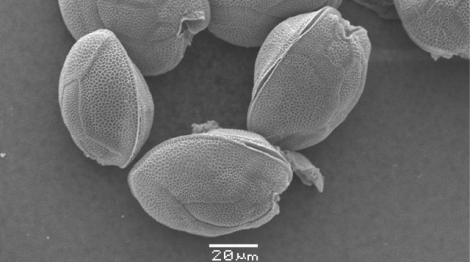
Profile: Marine toxins, new drugs
The research of Dr Luis M Botana’s group has centred on marine toxins for the past 25 years and has also explored the potential of these molecules as drug leads for therapeutic applications
About 100 different microalgae species produce marine toxins, which are a food safety concern because they produce acute intoxications which are sometimes lethal. There are about 1,000 different marine structures, potentially many more, and their presence in certain species of fish, bivalves and seafood causes several thousand intoxications every year.
Climate change is expanding the range of these toxins, as we have recently discovered for tetrodotoxin and ciguatoxins, and some of them, which are considered tropical, now have a constant presence in southern European coasts.
In the past years, we have dedicated an important effort to developing fast in vitro methods to detect and quantify these toxins because their high toxicity requires a constant monitoring of their presence by the authorities and producers. Our approach has always been the same: once we identify the receptor target to the toxin group, we use this receptor as a binder to an in vitro assay.
We have developed methods for all the toxin groups, represented by their reference compounds saxitoxin, okadaic acid, ciguatoxin, palytoxin, spirolide, yessotoxin, pectenotoxin and brevetoxin. We did not develop methods for domoic acid, as the analysis is fairly simple, or for azaspiracid, since the mechanism of action of this group is as yet unknown. For each of the groups the technologies used ranged from biosensors, such as the resonant mirror or the surface plasmon resonance, to polarisation fluorescence or radioactivity.
The main advantage of using receptors instead of antibodies is that receptors are able to detect any compound with the same mechanism of action, without the limitation of cross-reactivity typical of antibodies. Therefore, we have focused on development based on the binding to sodium-potassium ATPase (palytoxins, ovatoxins, ostreocins), phosphodiesterase 4 (yessotoxins), sodium channels (saxitoxin, gonyautoxins, ciguatoxin, brevetoxin, gambierona), actin (pectenotoxin), nicotinic receptors (spirolides and cyclic imines), and phosphatase 2A (okadaic acid and dinophysis toxins).
Given the fact that once the target is identified it is possible to study how it is modulated, a natural evolution to our work was to identify the potential therapeutic consequences of this modulation. The results were quite surprising as marine toxins are incredible molecules, both in terms of their structures and their effects. Our work has been the consequence of a fruitful collaboration with top research groups worldwide, especially from Japan, the US, France, the UK, Ireland and Portugal. This research was funded by several European framework programmes (Detectox, Biocop, Atlantox, microAqua, Spies-Detox, Ciguatools, Beads).
Therapeutic potential
Due to the ample variety of mechanisms of action, the potential damaging effect of marine toxins is rather complex: muscle paralysis, neuron death, hepatotoxicity, diarrhoea, organ damage, etc. But surprisingly, these same modes of action provide several extremely interesting potential uses.
The most fascinating molecule by far is yessotoxin. This is a polyether molecule of about 1,100 daltons with a complex mechanism in which phosphodiesterase 4A seems to play an important role in its apoptotic effect. We have found that yessotoxin is active at the nanomolar level to inhibit the growth of the majority of the US National Cancer Institute set of 60 tumour cell lines; in addition this is effective in inhibiting the in vivo growth of several tumour types induced in mice. Importantly, these apoptotic effects are not observed in non-malignant cells.
What is surprising about yessotoxin is that we have also observed an intense inhibitory effect of Alzheimer’s markers in triple transgenic mutated mice with Alzheimer’s and an important inhibitory effect of histamine release in rat mast cells (a marker of allergy), a very significant genomic decrease of metabolic markers, pointing at potential antidiabetic and anticholesterolemic use (all these effects were covered by their respective patents).
Although not with so many potential uses, we had also intellectual property of the use of gambierol (a derivative of ciguatoxin) and cyclic imines as anti-Alzheimer’s drugs. This research was funded by the European projects Pharmatlantic, BAMMBO and the ongoing PharmaSea.
Marine compounds
Even though marine toxins are many, the sea is a large reservoir of pharmacological compounds, especially sponges, fungi and bacteria. We have explored some compounds, such as crambescins and gracilins isolated from the sponge genera Crambe and Spongionella, respectively, or hymenialdisine and hymenin from an axinellid sponge, from cyanobacterium, autumnalamide from Phormidium autumnale, and anhydroexfoliamycin and undecylprodigiosin from Streptomyces – all of them show very promising effects as anti-Alzheimer’s compounds and for neurodegenerative disorders such as Parkinson’s disease and cerebral ischaemia, and some of them as immunosupressors.
Clearly, the major limitation to the use of these compounds is their chemical complexity, which means a challenge to organic chemists, their scarcity for studies involving large amounts, and the fact that intellectual property cannot be obtained as they are natural marine compounds.
Therefore, our current occupation is to replace the natural compound of interest to a therapeutic use with synthetic analogues for which intellectual property can be issued. This requires collaboration with strong organic chemistry groups as the stereochemistry and the structures themselves are in many cases affordable by only a few groups of international relevance.
The fact that marine compounds are privileged structures saves plenty of time to guess which are the best ones, since the number of possible stereoisomers is 299 for maitotoxin or 264 for palytoxin, which illustrates the immense complexity of the chemistry of marine compounds. Also, the rule of five described by Lipinski in 1997 does not often apply to many of these compounds.
Our conclusion is clear, the future of new pharmacological compounds resides largely in an unexplored field: the oceans.
Dr Luis M Botana
Group Director
Department of Pharmacology
University of Santiago de Compostela
Campus of Lugo
Spain
tel: + 34 982 822 233
http://www.usc.es/es/investigacion/grupos/farmacoloxia_ficotoxinas/





